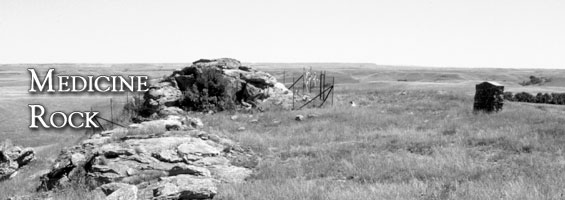We’ve launched a new web portal! Visit findhistory.nd.gov to search our collections.
Due to a road closure, the Killdeer Mountain Battlefield State Historic Site is temporarily closed.

Located along the north fork of the Cannonball River, Medicine Rock State Historic Site is one of six known American Indian rock art sites in North Dakota. It is the largest of the rock art sites in the state and exhibits the greatest variety of pictures, called glyphs. Historically, the Mandan and Hidatsa Indians regarded Medicine Rock as an oracle, and it continues to be used by American Indians as a sacred site. Offerings of tobacco and cloth testify to the ongoing significance of this place as a religious shrine. Medicine Rock was a historic landmark well known to early European explorers.
The religious significance of the site was documented by Lewis and Clark in 1804, personnel of Stephen H. Long’s expedition in 1819-1820, and German scientist and explorer Prince Alexander Philipp Maximilian in 1832-1834. It appears on historic maps from 1864 to 1872.
Although Meriwether Lewis and William Clark did not visit Medicine Rock, Clark’s journal for February 21, 1805, states:
The medicine-stone is the great oracle of the Mandans, and whatever it announces is believed with implicit confidence. Every spring, and on some occasions during the summer, a deputation visits the sacred spot, where there is a thick porous stone 20 feet in circumference, with a smooth surface. Having reached the place, the ceremony of smoking to it is performed by the deputies, who alternately take a whiff themselves and then present the pipe to the stone; after this they retire to an adjoining wood for the night, . . . in the morning they read the destinies of the nation in the white marks on the stone.
The most graphic description of the creation and interpretation of glyphs on Medicine Rock and its importance to the Hidatsas is in notes from the S. H. Long expedition. According to the expedition, the Hidatsas called the rock Me-ma-ho-pa and traveled two to three days to reach it from their villages. Upon arriving, an offering was left at the stone, tobacco was smoked, and a portion of the rock was washed. The supplicant would pray nearby. When he returned to the rock,
his presents are no longer there, and he believes them to have been accepted and carried off by the manhopa [Great Spirit] himself. Upon the part of the rock, which he had washed, he finds certain hieroglyphics traced with white clay, of which he can generally interpret the meaning . . . These representations are supposed to relate to his future fortune, or to that of his family or nation; he copies them off with pious care and returns to his home, to read from them to the people, the destiny of himself or of them . . . They say that an Indian, on his return from the rock, exhibited to his friends . . . the representation of a strange building, as erected near the village; . . . four months afterwards, the prediction was, as it happened, verified, and a stockade trading house was erected there, by the French trader Jessaume.
Incised or pecked pictures (petroglyphs) and painted figures (pictographs) cover the sandstone outcrop at Medicine Rock. Although eroded by time and, in some cases, defaced by vandals, many of the glyphs are identifiable. A rider on horseback, turtles, bighorn sheep, bear paw, handprint and footprint, bird track, and numerous hoof prints are visible.
Access to the site is difficult and crosses private land. For access information, contact the Historic Preservation Division, State Historical Society of North Dakota, 612 East Boulevard Avenue, Bismarck, North Dakota, 58505, or call (701) 328-2666.
SHSND Address:
612 East Boulevard Ave.
Bismarck, North Dakota 58505
Get Directions
SHSND Hours:
Museum Store: 8am - 5pm M-F; Sat. & Sun. 10am - 5pm.
State Archives: 8am - 4:30pm., M-F, except state holidays, and 2nd Sat. of each month, 10am - 4:30 pm.
State Historical Society offices: 8am - 5pm M-F, except state holidays.
Contact SHSND:
phone: 701.328.2666
email: history@nd.gov